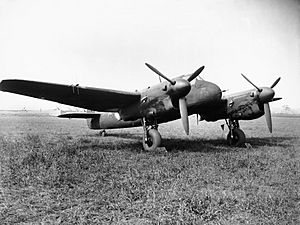Serrate radar detector facts for kids
Serrate was a special device used by RAF night fighters during World War II. It helped them find and track German night fighters. These German planes used a type of radar called Lichtenstein.
Serrate allowed British pilots to attack German planes that were trying to shoot down RAF bombers. It was like a secret weapon that turned the Germans' own radar signals against them!
The first Serrate systems were made from an older British radar called AI Mk. IV radar. It just so happened that the antennas of this radar were perfect for picking up the signals from the German Lichtenstein radar. Serrate worked by listening for these signals. It showed the direction of the German plane, but not how far away it was.
Pilots would watch the display carefully to guess if the German plane was close or far. When they thought it was close enough, they would switch back to their own radar to get a clear picture of the enemy plane and attack.
Serrate was first used by No. 141 Squadron RAF on September 7, 1943. In their first 179 missions, they claimed to have shot down 14 German fighters, while only losing 3 of their own planes.
The Germans soon realized what was happening. They quickly changed their radars to use different frequencies. This made the original Serrate less useful. New versions of Serrate were developed and fitted to faster de Havilland Mosquito planes. However, these later operations were not as successful as the first ones.
Later, another device called Perfectos was sometimes used instead of Serrate. Perfectos worked by sending a signal that made German planes respond with their IFF system. This allowed British planes to know both the direction and distance to the German aircraft.
How Serrate Helped Pilots Find Enemy Planes
The AI Mk. IV radar was one of the first radars used in planes. It started being used a lot in 1941. This radar had four antennas that could pick up signals from different directions. Two antennas looked up and down, and two looked left and right.
When the radar found a target, it showed two "blips" on a screen. The size of the blip showed how strong the signal was from that direction. By comparing the blips, the operator could tell if the target was above, below, left, or right of their plane.
The antennas for the Mk. IV radar were shorter than they ideally should have been. This was to reduce drag on the plane. By chance, the German radars used a wavelength that was perfect for these shorter British antennas to pick up. This made it possible to modify the British radar to listen for German signals.
By late 1941, newer radars like the AI Mk. VIII radar were being developed. These were much more advanced and used smaller antennas. They were mostly installed on the faster de Havilland Mosquito planes. This left many older Bristol Beaufighter planes with the Mk. IV radar.
The idea came up to use these older Beaufighters as "intruder" planes. They could fly into enemy airspace and hunt German night fighters. Since their old radars didn't have the new secret technology, there was no risk if one of these planes was lost.
This plan got a big boost in May 1943. A German Ju 88R-1 night fighter landed in Scotland with its crew defecting. This allowed the British to learn the exact frequencies of the latest German radars.
Serrate in Action
Serrate was used by RAF night fighters in a clever way. The British planes would fly slowly, pretending to be a heavy bomber. This would trick German night fighters into approaching them.
When the rear-facing Serrate detector picked up signals from an approaching German night fighter, the radar operator would guide the pilot. Once the German fighter was about 6,000 feet behind, the British Beaufighter would suddenly turn around. It would then use its front radar to find the enemy plane and try to shoot it down.
Serrate was also later put on the faster de Havilland Mosquito night fighters.
In late 1943, No. 141 Squadron RAF joined No. 100 Group of Bomber Command. During the Battle of Berlin on December 16/17, a Mosquito crew made the first successful attack using Serrate. They damaged a German Bf 110 plane. Serrate was an important part of the larger support operations carried out by No. 100 Group in 1944-45.
See also


